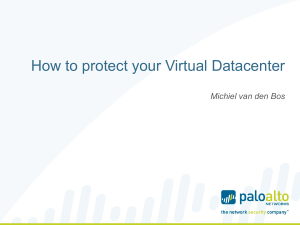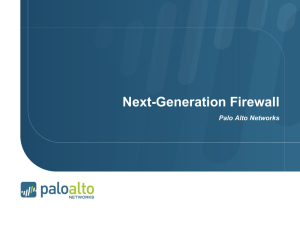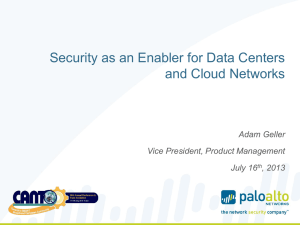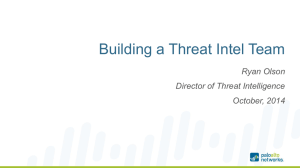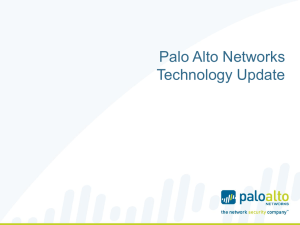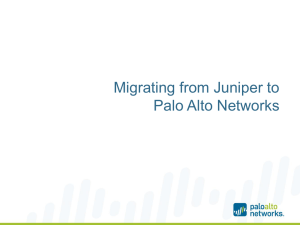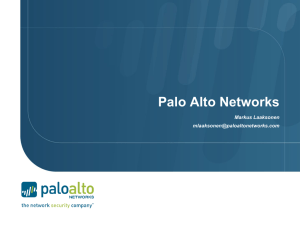About Palo Alto Networks
advertisement
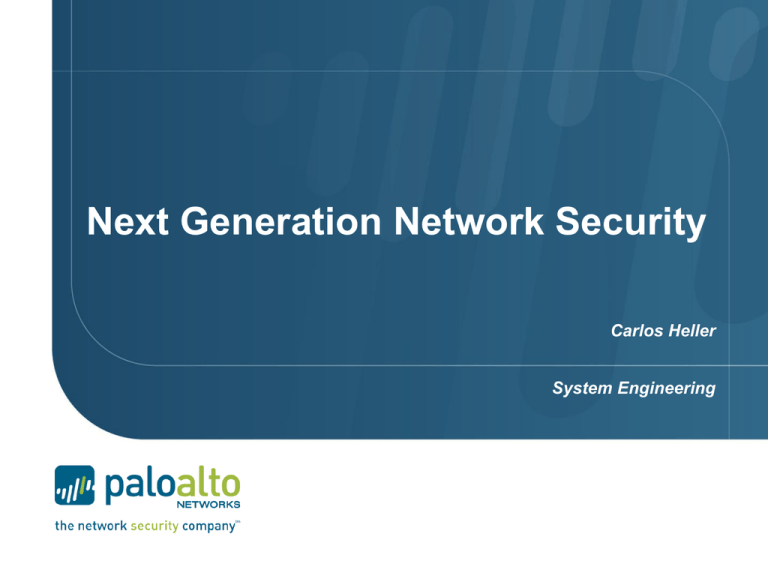
Next Generation Network Security Carlos Heller System Engineering Topics • About Palo Alto Networks Problems? • Current security situation • Proof! Page 2 | © 2010 Palo Alto Networks. Proprietary and Confidential. About Palo Alto Networks • Founded in 2005 by security visionaries and engineers from Checkpoint, NetScreen, Juniper Networks, McAfee, Blue Coat, Cisco, … • Build innovative Next Generation Firewalls that control more than 1000 applications, users & data carried by them • Backed by $65 Million in venture capital from leading Silicon Valley investors including Sequoia Capital, Greylock Partners, Globespan Capital Partners, … • Global footprint with over 2500 customers, we are passionate about customer satisfaction and deliver 24/7 global support and have presence in 50+ countries • Independent recognition from analysts like Gartner Page 3 | © 2009 Palo Alto Networks. Proprietary and Confidential. Over 2500 Organizations Trust Palo Alto Networks Health Care Financial Services Government Media / Entertainment / Retail Education Service Providers / Services Page 4 | Mfg / High Tech / Energy © 2010 Palo Alto Networks. Proprietary and Confidential. The current security situation Why Do You Need a NGFW? The Social Enterprise 2.0 Page 6 | © 2009 Palo Alto Networks. Proprietary and Confidential. Enterprise 2.0 Applications Take Many Forms As you can see, no space left for security ;-) Security v2.0: Stateful Inspection Traditional Applications • DNS • Gopher • SMTP • HTTP Dynamic Applications • FTP • RPC • Java/RMI • Multimedia • Background • Innovation created Check Point in 1994 • Used state table to fix Evasive Applications • Encrypted • Web 2.0 • P2P • Instant Messenger • Skype • Music • Games • Desktop Applications • Spyware • Crimeware packet filter shortcomings • Classified traffic based on port numbers but in the context of a flow • Challenge • Cannot identify Evasive Applications Internet • Embedded throughout existing security products • Impossible to retroactively fix Applications Carry Risk & and are targets Applications can be “threats” (P2P file sharing, tunneling applications, anonymizers, media/video, …) SANS Top 20 Threats – majority are application-level threats Applications & application-level threats result in major breaches – Pfizer, VA, US Army Page 9 | © 2010 Palo Alto Networks. Proprietary and Confidential. Applications Have Changed – Firewalls nor Firewall Helpers Have • Firewalls should see and control applications, users, and threats . . . . . . but they only show you ports, protocols, and IP addresses – all meaningless! Need to Restore Visibility, Control & Security in the Firewall Page 10 | © 2009 Palo Alto Networks. Proprietary and Confidential. Question to the audience! Why are Skype, Facebook, Google, Ultraserve and others behaving like they do ? Because users behave silly ! .They click links they shouldn’t ..They install Software they shouldn’t ...they are curious Because the current Security Infrastructure can’t stop them ! ..traditional Firewalls are blind to this …the Infrastructure technology is years older then the applications are Because it makes they Application successful ! .the application receives attention ..the application spreads even faster …the application generates revenue Page 11 | © 2010 Palo Alto Networks. Proprietary and Confidential. Your Control with a traditional Firewall + IPS You only can hit what you understand & see ! You are only in a reactive mode…..!! © 2010 Palo Alto Networks. Proprietary and Confidential. What You Need To Know • Driven by new generation of addicted Internet users – smarter than you? • Full, unrestricted ac`cess to everything on the Internet is a right. • They’re creating a giant social system - collaboration, group knowledge, … • Not waiting around for IT support or endorsement – IT is irrelevant! • Conclusion: Lots of Rewards but tremendous Risk! Sprawl Is Not The Answer Internet • “More stuff” doesn’t solve the problem • Firewall “helpers” have limited view of traffic • Complex and costly to buy and maintain • Putting all of this in the same box is just slow Page 14 | © 2009 Palo Alto Networks. Proprietary and Confidential. Why Existing Solutions Don’t Work • Traditional old fashioned firewalls - Doesn’t uniquely identify applications - All traffic on port 80/443 looks the same • IPS - Limited visibility - Doesn’t allow for safe enablement • URL Filtering - Incomplete view of traffic - Can be easily circumvented by proxies • Others Page 15 | Incomplete solution – do not identify or classify broad set of E2.0 applications © 2010 Palo Alto Networks. Proprietary and Confidential. What You See…with What You See with Withnon-firewalls a NG-Firewall © 2010 Palo Alto Networks. Proprietary and Confidential. What are the key differences ? Page 17Palo | Alto Networks. Proprietary and Confidential. © 2009 Unique Technologies Transform the Firewall App-ID Identify the application User-ID Identify the user Content-ID Scan the content Page 18 | © 2009 Palo Alto Networks. Proprietary and Confidential. App-ID is Fundamentally Different • Always on, always the first action • Sees all traffic across all ports • Built-in intelligence • Scalable and extensible Much more than just a signature…. © 2010 Palo Alto Networks. Proprietary and Confidential. Fundamental Differences: User-ID & Content-ID User-ID • User data is pervasive – • Single click visibility into who is using the application (ACC) • 3 click addition of user info in a policy • Report on, investigate application usage, threat propagation • None of the competitors are as pervasive, nor as easy to use © 2010 Palo Alto Networks. Proprietary and Confidential. Content-ID • Seamlessly integrated – app intelligence is shared • Compliments application control – block the unwanted, scan the allowed • Single pass scanning minimizes performance hit and latency Single-Pass Parallel Processing (SP3) Architecture Single Pass • Operations once per packet - Traffic classification (app identification) - User/group mapping - Content scanning – threats, URLs, confidential data • One policy Parallel Processing • Function-specific hardware engines • Separate data/control planes Up to 10Gbps, Low Latency Page 21 | © 2009 Palo Alto Networks. Proprietary and Confidential. Your Control With A Palo Alto Networks NGFW © 2010 Palo Alto Networks. Proprietary and Confidential. Visibility into Application, Users & Content • Application Command Center (ACC) - View applications, URLs, threats, data filtering activity • Mine ACC data, adding/removing filters as needed to achieve desired result Filter on Skype Page 23 | Filter on Skype and user harris © 2009 Palo Alto Networks. Proprietary and Confidential. Remove Skype to expand view of harris Enables Visibility Into Applications, Users, and Content Page 24 | © 2008 2009 Palo Alto Networks. Proprietary and Confidential. The Right Answer: Make the Firewall Do Its Job New Requirements for the Firewall 1. Identify applications regardless of port, protocol, evasive tactic or SSL 2. Identify users regardless of IP address 3. Protect in real-time against threats embedded across applications 4. Fine-grained visibility and policy control over application access / functionality 5. Multi-gigabit, in-line deployment with no performance degradation Page 25 | © 2010 Palo Alto Networks. Proprietary and Confidential. A True Firewall: PAN-OS Features • Strong networking foundation - Dynamic routing (OSPF, RIPv2) - Site-to-site IPSec VPN - SSL VPN for remote access - Tap mode – connect to SPAN port - Virtual wire (“Layer 1”) for true transparent in-line deployment - L2/L3 switching foundation • QoS traffic shaping - Max/guaranteed and priority - By user, app, interface, zone, and more • Zone-based architecture - 10Gbps; 5Gbps threat prevention (XFP interfaces) PA-4060 10Gbps; 5Gbps threat prevention PA-4050 2Gbps; 2Gbps threat prevention PA-4020 All interfaces assigned to security zones for policy enforcement • High Availability - Active / passive - Configuration and session synchronization - Path, link, and HA monitoring 1Gbps; 500Mbps threat prevention PA-2050 500Mbps; 200Mbps threat prevention PA-2020 • Virtual Systems - Establish multiple virtual firewalls in a single device (PA-4000 Series only) • Simple, flexible management - CLI, Web, Panorama, SNMP, Syslog Page 26 | © 2009 Palo Alto Networks. Proprietary and Confidential. PA-500 250Mbps; 100Mbps threat prevention Addresses Three Key Business Problems • Identify and Control Applications - Visibility of 4000+ applications, regardless of port, protocol, encryption, or evasive tactic - Fine-grained control over applications (allow, deny, limit, scan, shape) - Addresses the key deficiencies of legacy firewall infrastructure Prevent Threats - Stop a variety of threats – exploits (by vulnerability), viruses, spyware - Stop leaks of confidential data (e.g., credit card #, social security # - Stream-based engine ensures high performance - Enforce acceptable use policies on users for general web site browsing Simplify Security Infrastructure - Put the firewall at the center of the network security infrastructure - Reduce complexity in architecture and operations Page 27 | © 2010 Palo Alto Networks. Proprietary and Confidential. Security needs to be flexible! Global Protect! GlobalProtect: Complete Security Coverage Solution Consistent policy applied to all enterprise traffic: • Users protected from threats off-network, plus application and content usage controls • User profile incorporated into consistent enterprise security enforcement • Enterprises gain same level of control of SaaS applications as when previously hosted internally Users Headquarters Branch Office Consistent Security Hotel Home The Proof! Page 30Palo | Alto Networks. Proprietary and Confidential. © 2009 2010 Magic Quadrant for Enterprise Network Firewalls Cisco ability to execute Juniper Networks McAfee Fortinet Check Point Software Technologies Stonesoft Palo Alto Networks SonicWALL WatchGuard NETASQ Astaro phion 3Com/H3C niche players Source: Gartner Page 31 | visionaries completeness of vision © 2010 Palo Alto Networks. Proprietary and Confidential. As of March 2010 Proven IPS Quality Summary of NSS Labs results Standalone Test Q3 2010 Read the full Palo Alto Networks Report here © 2010 Palo Alto Networks. Proprietary and Confidential. NSS Group Test Q4 2009 Get more information on the 2009 Group Test here Thank You Page 33 | © 2010 Palo Alto Networks. Proprietary and Confidential. App-ID Page 29 © 2007 2009 Palo Alto Networks. Proprietary and Confidential | What is an Application? •GMail •GTalk •Google Calendar •iGoogle •Siebel CRM •eMule •UltraSurf Traditional Systems Cover Portions of the Problem Some port-based apps caught by firewalls (when well-behaved) Some web-based apps caught by URL filtering or proxy Some evasive apps caught by IPS None give a comprehensive view of what is going on in the network App-ID: Comprehensive Application Visibility • Policy-based control more than 900 applications distributed across five categories and 25 sub-categories • Balanced mix of business, internet and networking applications and networking protocols • 3 - 5 new applications added weekly • App override and custom HTTP applications help address internal applications Application Identification Engine detects initial application regardless of port and protocol – decrypts SSL if necessary Engine decodes protocol in order to apply additional application signatures as well as to detect vulnerabilities, viruses, spyware, and sensitive information Engine checks applicable signatures to see if a more specific application is tunneling over the base protocol or application If no match is found heuristics are applied to detect application that use proprietary encryption and port hopping Application Examples Tunneled App Example SSL Example Heuristic Example Detect SMTP protocol Decrypt SSL and discover internal HTTP protocol ??? Decode SMTP protocol fields Decode HTTP protocol fields ??? Apply signatures to detect HOSProxy Apply signatures to detect Meebo ??? Skype, Ultrasurf, eMule, Bitorrent User-ID User-ID: Enterprise Directory Integration • Users no longer defined solely by IP address - Leverage existing Active Directory infrastructure without complex agent rollout - Identify Citrix users and tie policies to user and group, not just the IP address • Understand user application and threat behavior based on actual AD username, not just IP • Manage and enforce policy based on user and/or AD group • Investigate security incidents, generate custom reports User-ID Mechanism • Agent provides access to •User Identification Agent •User & Group Info •User-to-IP Mapping •Security Logs •Domain Controller user and group information to the firewalls • When a user logon occurs, •NetBIOS Probe agent detects this and sends user to IP mapping to firewall • Agent will periodically poll •Logon end stations to determine if user has moved • Correlated user information is available in ACC, logs, and reports • User and/or group •Corporate Users information can be used in policy Content-ID Content-ID: Real-Time Content Scanning •Detect and block a wide range of threats, limit unauthorized data transfer and control non-work related web surfing • Stream-based, not file-based, for real-time performance - Uniform signature engine scans for broad range of threats in single pass - Vulnerability exploits (IPS), viruses, and spyware (both downloads and phone-home) • Block transfer of sensitive data and file transfers by type - Looks for CC # and SSN patterns - Looks into file to determine type – not extension based • Web filtering enabled via fully integrated URL database - Local 20M URL database (76 categories) maximizes performance (1,000’s URLs/sec) - Dynamic DB adapts to local, regional, or industry focused surfing patterns Content-ID Uses Stream-Based Scanning File-based Scanning Stream-based Scanning ID Content ID Content Buffer File Scan Content Scan File Deliver Content Deliver Content Time Time • Stream-based, not file-based, for real-time performance - Dynamic reassembly • Uniform signature engine scans for broad range of threats in single pass • Threat detection covers vulnerability exploits (IPS), virus, and spyware (both downloads and phone-home) Microsoft Security Bulletins • Active member in MAPP (Microsoft Active Protections Program) - Receive early access to Microsoft vulnerability info • Close working relationship with Microsoft - Threat researchers closely collaborating with Microsoft on new ways to research vulnerabilities • Responsible for discovering 17 Microsoft vulnerabilities over the last 18 months - 7 Critical and 2 Important severity already published - 8 Microsoft vulnerabilities are currently pending
